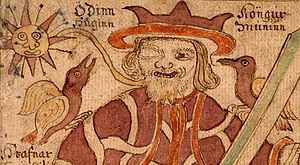http://www.medievalists.net/2012/09/30/the-language-of-birds-in-old-norse-tradition/?utm_content=buffer3f6d4&utm_medium=social&utm_source=twitter.com&utm_campaign=buffer
The Language of Birds in Old Norse Tradition

Bourns, Timothy
Master’s Thesis, University of Iceland (2012)
Abstract: Select characters in medieval Icelandic literature are able to comprehend the language of birds. Ranging from Sigurðr’s tasting the blood of the dragon Fáfnir to Óðinn’s daily dialogue with the ravens Huginn and Muninn, numerous sources will be examined from a comparative perspective. Birds consistently offer important information to individuals associated with kingship and wisdom. The wide chronological and geographical range of this motif will be explored as well as the fascinating theoretical questions regarding why birds are nature’s purveyors of wisdom. With their capacity to fly and sing, birds universally hold a special place in human experience as symbols of transcendence and numinous knowledge; Old Norse tradition reflects this reality.
Introduction: During the early travels of Oddr and Ásmundr in Örvar-Odds saga, these sworn-brothers come to a large and well-lit hall in Bjarmaland. They see many people enjoying themselves inside. Oddr asks, “Skilr þú hér nokkut mál manna?” In response, “Eigi heldr en fuglaklið,” sagði Ásmundr. “Eða þykkist þú nokkut af skilja?” Oddr answers, “Eigi er þat síðr”. For Oddr and Ásmundr, the language of birds is deemed incomprehensible; but for other characters in Old Norse tradition, bird-speech is not so foreign.
Special individuals capable of understanding the language of birds are spread throughout the medieval Icelandic literary corpus. This phenomenon has received surprisingly little academic attention and is deserving of detailed, extensive, and interdisciplinary study. Capable of flight and song, birds universally hold a special place in human experience. Their effective communication to people in Old Norse lore offers another example of their unique role in humanity’s socio-cosmic reality.



0 Comentarios